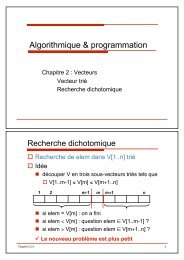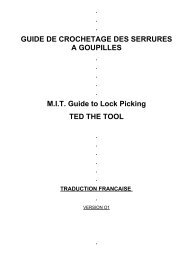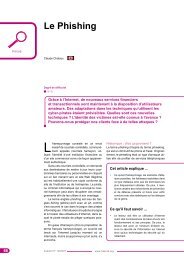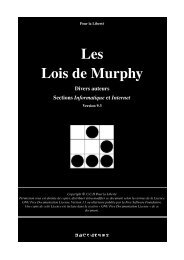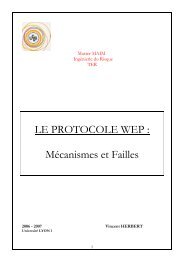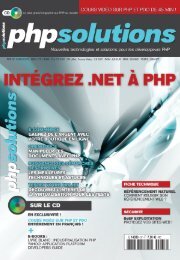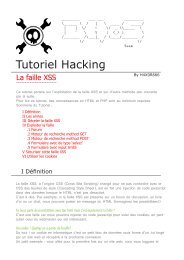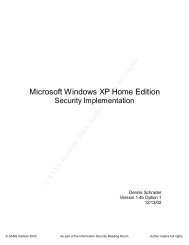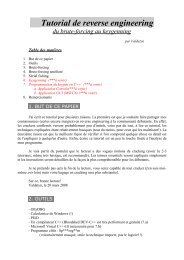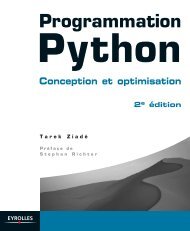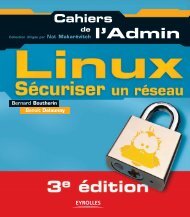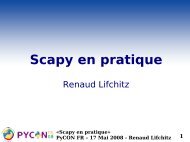How to Steal an Election by Hacking the Vote - repo.zenk-securit...
How to Steal an Election by Hacking the Vote - repo.zenk-securit...
How to Steal an Election by Hacking the Vote - repo.zenk-securit...
You also want an ePaper? Increase the reach of your titles
YUMPU automatically turns print PDFs into web optimized ePapers that Google loves.
1<br />
2<br />
3<br />
C<strong>an</strong>didate<br />
C<strong>an</strong>didate<br />
C<strong>an</strong>didate<br />
C<strong>an</strong>didate<br />
C<strong>an</strong>didate<br />
Board of<br />
<strong>Election</strong>s<br />
http://arstechnica.com/articles/culture/evoting.ars<br />
C<strong>an</strong>didate C<strong>an</strong>didate<br />
C<strong>an</strong>didate<br />
C<strong>an</strong>didate<br />
C<strong>an</strong>didate C<strong>an</strong>didate<br />
C<strong>an</strong>didate<br />
S<strong>an</strong>Disk<br />
C<strong>an</strong>didate<br />
C<strong>an</strong>didate<br />
C<strong>an</strong>didate<br />
C<strong>an</strong>didate<br />
C<strong>an</strong>didate<br />
Figure 1: Electronic voting using <strong>an</strong> optical sc<strong>an</strong>ner<br />
The three steps depicted in Figure 1 are as follows:<br />
1. After receiving a paper ballot from poll workers, <strong>the</strong> voter marks her<br />
choices on <strong>the</strong> ballot <strong>by</strong> filling in bubbles with a pen. (An optical sc<strong>an</strong> ballot<br />
looks <strong>an</strong>d functions much like <strong>the</strong> multiple choice bubble sheets used in<br />
st<strong>an</strong>dardized tests.)<br />
2. The marked ballot is <strong>the</strong>n fed in<strong>to</strong> <strong>the</strong> optical sc<strong>an</strong> voting machine, where<br />
<strong>the</strong> voter's choices are tr<strong>an</strong>slated in <strong>the</strong> 1s <strong>an</strong>d 0s of computer l<strong>an</strong>guage<br />
<strong>an</strong>d s<strong>to</strong>red, along with <strong>the</strong> rest of <strong>the</strong> votes cast on that machine, in <strong>the</strong><br />
machine's internal memory. (I've depicted <strong>the</strong> internal s<strong>to</strong>rage as a<br />
S<strong>an</strong>Disk Flash PCMCIA card of <strong>the</strong> type commonly used in <strong>the</strong> Diebold DRE<br />
described below, but o<strong>the</strong>r s<strong>to</strong>rage formats are possible.)<br />
3. At <strong>the</strong> end of <strong>the</strong> election, when all of <strong>the</strong> votes have been cast <strong>an</strong>d are<br />
s<strong>to</strong>red in <strong>the</strong> optical sc<strong>an</strong> machines, <strong>the</strong> contents of <strong>the</strong> machines' internal<br />
s<strong>to</strong>rage devices are <strong>the</strong>n tr<strong>an</strong>smitted <strong>to</strong> <strong>the</strong> county Board of <strong>Election</strong>s<br />
(BOE) for tallying <strong>an</strong>d archiving. The marked paper ballots are also<br />
archived, in case a m<strong>an</strong>ual audit is dem<strong>an</strong>ded.<br />
There are some variations in <strong>the</strong> process listed above (e.g., all of <strong>the</strong> votes in a<br />
single precinct c<strong>an</strong> be tallied before being sent off <strong>to</strong> <strong>the</strong> BOE), but in general it<br />
describes overall movement of votes in <strong>the</strong> voting process.<br />
Direct-recording electronic (DRE) machines<br />
The steps involved in voting with DREs are similar <strong>to</strong> those described for optical sc<strong>an</strong><br />
machines, but <strong>the</strong>re are some critical differences. Figure 2 illustrates what we might<br />
call <strong>the</strong> "life-cycle of a vote" in <strong>the</strong> DRE-based voting process.<br />
S<strong>an</strong>Disk<br />
4




